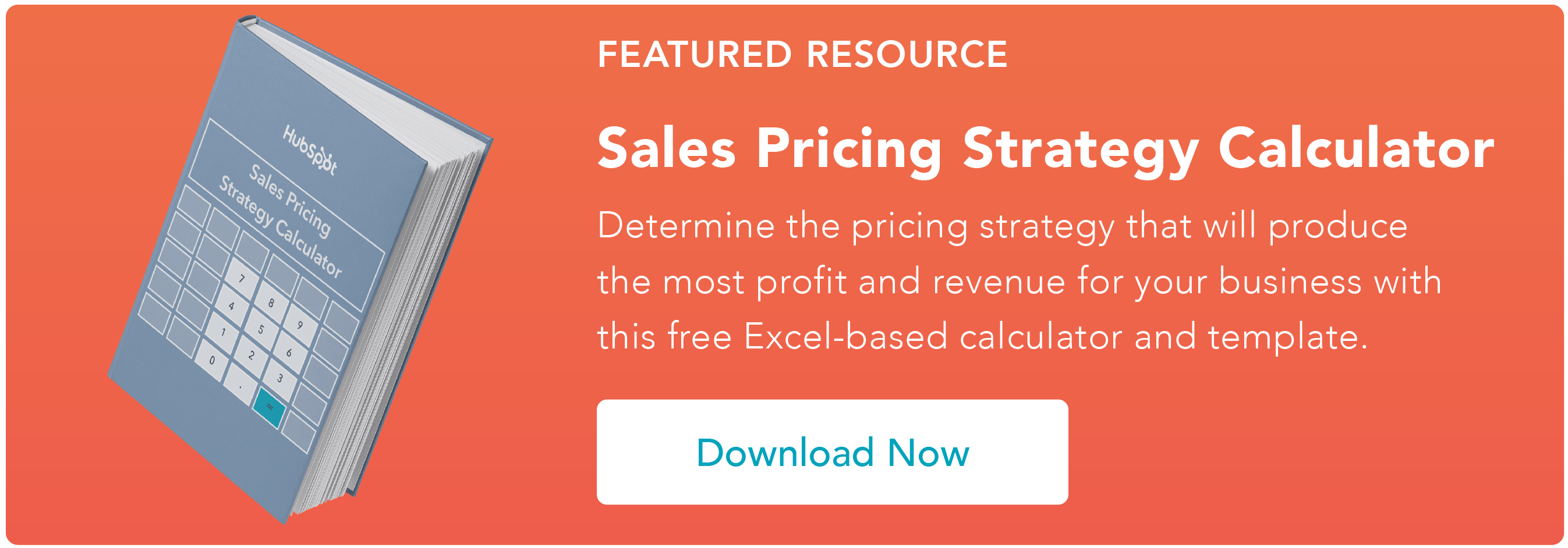As a consumer, when I’m looking to buy something, one of the first things I do is look at the price. First, I need to gauge what the average price of the product or service is, and then I need to decide on my budget and what I’m willing to spend.
All of your customers will go through this journey, so deciding on the price of your services in relation to the competition is an important strategic decision.
In this post, we’ll review what price competition is, go over real-world examples, and give you tips on how to create a competitive pricing strategy for yourself.
- Common Competitive Pricing Strategies
- Price Competition Examples
- How to Create a Competitive Pricing Strategy
Many businesses base prices solely on business costs or target profit margins. The price competition strategy, however, makes sense for products or services that are very similar to the competition. Basing pricing off price competition can increase sales, market share, brand awareness, and customer loyalty.
Now, you might be wondering, “What does this have to do with sales?” Good question. The price that you set your service at will directly impact your sellers.
They can either boast about the low cost, or they’ll need to answer the common objection of pricing and discuss why your service might be priced higher than the competition (mainly quality and value).
Advantages and Disadvantages of Competitive Pricing
As I mentioned above, price competition can increase sales, market share, brand awareness, and customer loyalty, especially if your price is lower than the competition. However, you can use price competition to validate a higher price point because of your unique value proposition.
You might try to reduce manufacturing costs, but that could potentially reduce the quality of your product. Plus, you might decrease your profit margins and lower overall revenue, which is the exact opposite effect you want to have.
You’ll walk a fine line with competitive pricing. Risk a lower profit margin for increased sales, counteracting the loss of revenue, or choose a higher-end price to communicate value and quality, but then put your sellers at risk of having to overcome that objection every time they try to close a sale.
If you want to learn more, continue reading to find out about the common competitive pricing strategies (yes, there are a few).
Common Competitive Pricing Strategies

1. Penetration
Penetration pricing is when you offer a noticeably lower price than the competition. It might even be one of your main marketing messages — “Come here for the same quality at a lower price.”
What we like: This strategy is usually effective for new businesses because it helps them build a customer base quickly.
2. Promotional
Promotional pricing is when you incorporate discounts or freebies as a part of your price structure.
Think Kohl’s: Every time I go to Kohl’s, there’s a sale. Every single item shows a discount, which helps entice shoppers to buy more. It attracts customers and can help you win more sales.
Pro tip: If we’re talking B2B, think about the freemium pricing model. Many software companies have a free version of their product, and they work on upselling or cross-selling.
3. Captive
Captive product pricing is when the price of one of your products is tied to another. This pricing strategy makes sense when a customer needs to buy two products together.
For example, you might sell a unique printer at a lower price point, and you’re the only company that sells the ink cartridge for that printer.
With a captive price strategy, you could price the ink cartridge a little bit higher than the normal market rate price because customers have to go through you to get it. The higher price point could create a sense of exclusivity and increase brand recognition.
It’s important to keep in mind that certain practices related to captive pricing can raise antitrust or competition law concerns. An example of this is if a company uses its monopoly to artificially inflate prices of complementary products.
While these are the top competitive pricing strategies, there are others, including price skimming or price matching. Now, let’s see how this works in the real world.
Price Competition Examples
1. Apple
If you’ve ever bought an Apple product, you know that they sell the chargers and accessories separately and at a higher price than competitors. That’s because they use a captive product pricing strategy.
Their products are sold for premium prices, and the other products that you can only get through them are high priced as well. It’s helped them capture a large percentage of the market share and increase profits.
2. Amazon
Amazon is another example of a captive pricing strategy. Many of the products on the site are available at a lower cost, such as books, clothing, electronics, etc. However, they also offer Amazon-branded products such as Kindle e-readers, Fire tablets, and Echo speakers at a higher price.
3. Uber and Lyft
Uber and Lyft are the two dominating ride-share apps, and they both employ a promotional pricing strategy. They frequently offer discounts and promotions. These competitors monitor each other’s pricing to remain competitive. This often means lower pricing for the consumer.
Additionally, we know that both ride-share apps have peak pay times and increase their prices depending on the demand and traffic (a dynamic form of captive pricing). This shows that they oscillate between pricing strategies.
4. Microsoft Teams vs. Slack
Slack used to be the leader in the collaboration tool market. However, when Microsoft Teams employed a penetration pricing strategy and offered a noticeably lower price for similar functionality and packages bundled with other Microsoft products, they pulled ahead as the leader in the space.
Their pricing strategy had a massive impact on who was leading the collaboration tool market, and Slack has had to adjust pricing just to compete. (Interesting note: Slack sued Microsoft Teams for violating antitrust laws. Read more about it here.)
Now that we know what pricing strategies there are, let’s review how you can create a competitive pricing strategy for your business.
How to Create a Competitive Pricing Strategy

1. Research industry standards.
Before you get into the nitty-gritty of competitive analysis (that’s step 2), you’ll want to research the industry standards. Look at charts or create your own charts with data available online for the average cost of your product or service. You can create a chart that lists competitor prices and includes a line indicating the average so you know whether you want to price on the lower or higher end.
This is just a high-level step so you’re aware of what the price is usually set at. It’s important to find out who charges the most and how much market share they have – this will answer the question: Are people willing to pay that high price?
Just because a competitor offers a premium price doesn’t mean customers are okay with spending that much on their product. You’ll want to know this at a high level: what are people willing to spend?
2. Complete a competitive analysis.
Once you know more about the market and industry standards, it’s time to complete a full competitive analysis.
List your top competitors and create an Excel or Google Sheet that can compare the competition with each other. You’ll want to track price, features, customer sentiment analysis, where you win versus where they win, and where you lose versus where they lose.
You’ll be able to see at a glance what the best features are and how your product or service stacks up to the competition. Including a customer sentiment analysis is important because they might have a lower-priced product but are known for poor quality.
To track this, you’ll want to look through their social media engagement and reviews and see what people are saying about them online.
You can also track what you think their pricing strategy is. After collecting the prices for your top competitors, you’ll see who is lower priced and who is aiming for premium pricing.
A competitive analysis will help you track the quality of the offerings in your industry, the prices, and the value and benefits that you provide over the competition.
Plus, you’ll learn what customers are willing to pay for. Do customers buy those premium-priced products? How much of the market share does that company have of the total market demand?
Additionally, you’ll want to analyze the competition pricing strategy: Do they have discounts for specific products during specific periods (seasonality)? Do they use dynamic pricing? Knowing this information will help you choose your pricing strategy.
3. Choose business objectives.
At this point, you’ve gathered all your research, but before you decide on a pricing strategy, think about your goals and objectives. We’ve all read about SMART goals and how knowing your objective is the best way to decide on a winning strategy. Aimlessly making these decisions won’t be helpful.
So, are you a new business that’s looking to disrupt the market? Or maybe you have a business that’s already running, and you want to increase sales? Do you see how the pricing strategy for those two situations might be different?
The right pricing strategy for you depends on whether you want to maximize profit share (you’ll probably use a penetration pricing strategy), gain market share (you might use a captive pricing strategy like Apple and Amazon), or increase sales (you’ll use a penetration strategy here).
4. Decide on the best strategy for your company.
With your goals all written out and your research detailed, you can make the best choice for which strategy will help you reach your goals. You’ll want to choose the strategy that will communicate your unique value proposition over the competition, and choose the pricing strategy that will help you stand out.
When you decide on a pricing strategy, it’s time for your marketing team to start implementing that messaging — premium prices with higher quality, same quality with lower prices, etc. The pricing strategy will help you determine how to position yourself in the market.
Set Your Strategy
Like Taylor Swift says, “If you fail to plan, you plan to fail.” Businesses shouldn’t just price products based on overhead and manufacturing costs. It’s also a strategic decision that can help position your company apart from the competition. Plus, the pricing strategy you use will depend on your goals and objectives.
Editor's note: This article was originally published in September 2013 and has been updated for comprehensiveness.
Pricing Strategy
.png?width=112&height=112&name=Image%20Hackathon%20%E2%80%93%20Vertical%20(45).png)









![Price Skimming: All You Need To Know [+ Pricing Calculator]](https://53.fs1.hubspotusercontent-na1.net/hubfs/53/price-skimming-strategy.jpg)

.jpg)